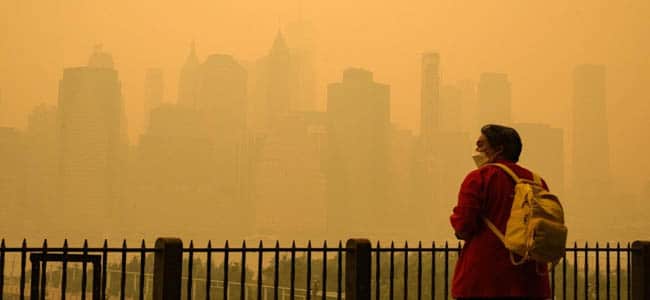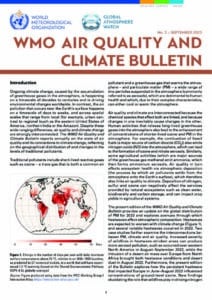
Exposure to air pollution significantly increases the risk of strokes, heart and lung disease, cancer and other ailments, causing more than 6.7 million premature deaths a year. [UNEP]
Climate change is increasing the intensity and frequency of heatwaves, and that is having measurable impacts on air quality and human health, according to a report published September 6 by the Geneva-based World Meteorological Organization (WMO).

The WMO Air Quality and Climate Bulletin reports annually on the state of air quality and its connections to climate change. (Click image for pdf.)
The 2023 WMO Air Quality and Climate Bulletin focuses on heatwaves, showing that it is not just high temperatures which are a hazard, but also the impacts of resulting pollution which are often overlooked but are just as pernicious.
It shows that heatwaves triggered wildfires in the northwestern United States and heatwaves accompanied by desert dust intrusions across Europe both led to dangerous air quality in 2022. It also includes case studies from Brazil on how parks and tree-covered areas within cities can improve air quality, absorb carbon dioxide and lower temperatures, thus benefiting inhabitants.
Introducing the report, WMO Secretary-General Petteri Taalas said:
“Heatwaves worsen air quality, with knock-on effects on human health, ecosystems, agriculture and indeed our daily lives. Climate change and air quality cannot be treated separately. They go hand-in-hand and must be tackled together to break this vicious cycle.
“This Air Quality and Climate Bulletin relates to 2022. What we are witnessing in 2023 is even more extreme. July was the hottest ever month on record, with intense heat in many parts of the northern hemisphere and this continued through August.
“Wildfires have roared through huge swathes of Canada, caused tragic devastation and death in Hawaii, and also inflicted major damage and casualties in the Mediterranean region. This has caused dangerous air quality levels for many millions of people, and sent plumes of smoke across the Atlantic and into the Arctic.”
Climate change is increasing the frequency and intensity of heatwaves, and this trend is expected to continue in the future. There is growing scientific consensus that heatwaves will increase the risk and severity of wildfires. Lorenzo Labrador, a WMO scientific officer in the Global Atmosphere Watch network which compiled the Bulletin, warns that
“Heatwaves and wildfires are closely linked. Smoke from wildfires contains a witch’s brew of chemicals that affects not only air quality and health, but also damages plants, ecosystems and crops – and leads to more carbon emissions and so more greenhouse gases in the atmosphere.”
Climate and air quality interaction
Climate change caused by heat-trapping greenhouse gases from human activities is a long-term global threat. In contrast, air pollution happens on a timescale of days to weeks and tends to be more localized.
Pollutants include short-lived reactive gases such as nitrogen oxides and biogenic volatile organic compounds which lead to the production of ozone — a trace gas that is both a common air pollutant and a greenhouse gas — and particulate matter — a wide range of tiny particles often called aerosols suspended in the atmosphere, which harm human health.
Air quality and climate are interconnected because the chemical species that affect both are linked, because the substances responsible for climate change and for the degradation of air quality are often emitted by the same sources, and because changes in one inevitably cause changes in the other.
For example, the combustion of fossil fuels emits carbon dioxide and nitrogen oxide into the atmosphere, which can lead to the formation of ozone and nitrate aerosols. Similarly, some agricultural activities are major sources of the greenhouse gas methane and also emit ammonia, which then forms ammonium aerosols which negatively impact air quality.
Air quality in turn affects ecosystem health because air pollutants such as nitrogen, sulfur and ozone are absorbed by plants, harming the environment and reducing crop yields.
2022 events
The summer of 2022 was the hottest on record in Europe. The long-running heatwave led to increased concentrations of both PM and ground-level ozone. Hundreds of air quality monitoring sites exceeded the World Health Organization’s ozone air quality guideline levels.
Whilst high-altitude ozone protects us from the harmful ultra-violet rays of the sun, ozone close to the Earth’s surface is harmful to human health. It also can reduce both the quantity and quality of yield of staple food crops. Globally, ozone-induced crop losses average 4.4%–12.4% for staple food crops, with wheat and soybean losses as high as 15%–30% in key agricultural areas of India and China.
Heatwaves and dry conditions are conducive to wildfires which, once started, grow rapidly as they encounter dry, easily combustible vegetation. Such situations can lead to an increase in aerosol emissions.
Thus, a lengthy heatwave in September 2022 correlated with anomalously high levels of biomass burning across the north-western United States, leading to unhealthy air quality across much of the region, as reported by the United States Environmental Protection Agency. In California and the north-west United States, fires were found to contribute large proportions of Nitrogen deposition in several natural ecosystems, often exceeding critical load thresholds and negatively impacting biodiversity, clean drinking water, and air quality via emissions that lead to further air pollution.
(Adapted from materials provided by the World Meteorological Organization.)


